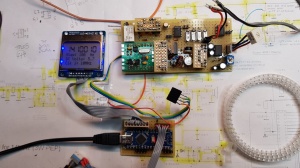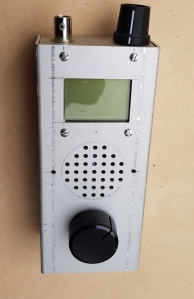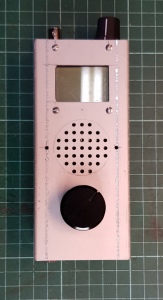This one follows the design of the DK7IH Cigarette Packet Micro Transceiver. The changes made to the original design are:
– Plug in front end, transmit driver and PA low pass filters
– FET power amplifier (IRF510) rather than bipolar
– Toroid filters for front end, transmit driver and PA low pass filter
– Discrete crystal SSB filter
– Nokia type LCD display
The construction is mostly SMD on the bottom of the board, with leaded parts on the top side of the board. I didn’t make a PCB for this one, it is built on pad per hole prototyping board. Earthing could be a problem, so lots of earth run around the board underneath. It does look rather untidy compared to the previous compact transceivers where a PCB was made. Maybe a PCB later on if it works out ok.
I like the idea of swapping the clock generator outputs to the mixers in software for receive to transmit switching. It certainly simplifies re-use of the mixers for transmit and receive.
So far the receiver is working fine, with a 0.1 uV minimum discernible signal (MDS). Still some work to do on software before the transmitter can be tested. The SSB filter is slightly broader (~ 4kHz wide) than intended although the response shape is good.
The main transceiver and clock generator board is 50mm x 100mm. With some luck it will fit into a 60mm x 120mm x 35mm enclosure. It may end up being a hand held type HF radio if things work out. Of course, it will need a trailing ground if used in this configuration. There also needs to be some access to the plug in band modules on the enclosure.
Mechanics test fit:




Nice work Glenn, good to see you are still building your own novel SSB transceivers. Peter DK7IH has certainly inspired me, I built a version of his Micro42 rig with success, his design worked exactly as I expected with no surprises. So simple too. This is the design where the script swaps the VFO and BFO at receive to transmit and vice versa, a clever scheme — minimises parts and space, and avoids switching in the signal path.
I particularly like his AGC circuit, for some reason I haven’t always found AGCs the easiest thing to get working well. My build of his AGC delivers smooth receiver gain control. I found it easy to experiment with the resistors in the MOSFET gain stages to adjust overall gain.
Note that you’ve used the miniature telco relay from Altronics, these are excellent pieces, I used one as a T/R relay in my DK7IH rig, so it is switching over 5 watts of SSB and CW carrier on 80 and 40m without issue. And you’ve copied Peter’s matrix board construction technique. I’ve never tried it but Peter has mastered it. He sometimes uses small pieces of thin brass modeler’s sheet as a ground plane or shield.
I don’t recognise the green board on the main matrix board, is this an si5351 breakout? And are you using Peter’s script as the controller?
This is such a minimal, simple design, if someone wanted to design and run up a batch of compact PCBs, I think it would make a fine SSB/CW monoband SOTA project rig.
Hope to see it working at Mt Hotham next time! 73 from Paul VK3HN.
Thanks Paul, he does have some nice designs and that idea of swapping the LOs around simplifies things.
Great to hear that your build worked out. The AGC seems to function, have not done any real tests though yet.
I took the idea for the telco relay from your blog I think! The matrix technique is certainly a fast build during a wet winters weekend.
The green board is an Si5351 breakout from QRP labs. I had one lying around so pressed it into service. The software is my own so far, I did not see Peter’s software published. The display I am using is different in any case. If it all works out ok, I might to a PCB for it.
Looking forward to the next Hotham weekend, it does seem a long way off though! Cheers, Glenn.
Yes, summer seems a very long way off, from where I sit, wrapped in my warmest winter coat. Hope to work you a few times before then. 73 Paul VK3HN.
Looks great, what are the power supply requirements?
So far running it on receive from 12V, so it should be fine on 3 cell Lipo or 4 cell LiFe.
Pingback: NanoVNA and EFHW | VK3YY
Cool design, like that very much! 😉 73 de Peter (DK7IH)